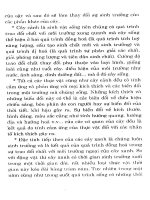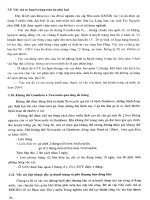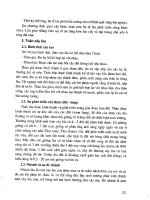Raising Turkeys - Part 2 potx
Bạn đang xem bản rút gọn của tài liệu. Xem và tải ngay bản đầy đủ của tài liệu tại đây (185.27 KB, 9 trang )
Brooding young turkey poults is one of the most enjoyable and
important phases of turkey raising. During this period, the
young poults grow rapidly beneath a warm brooder in a con-
fined area. A brooder is a heating unit that provides the warmth
necessary to help the poult maintain its body temperature until
it is old enough to do so on its own. Brooders can be gas or
electric. Several types can be purchased from commercial or
mail-order poultry-supply companies, agriculture-supply com-
panies, or feed- or farm stores.
One of the most important factors in brooding is to start off
with good-quality poults. All poults are not equal in their
health, liveliness, or general ability to live and grow. Good-
quality poults are a joy to raise. Poor-quality poults have
decreased chances for survival and may experience difficulties
for their entire rearing period. Another critical factor is provid-
ing proper care to young poults, especially during the first 2 to 3
weeks. Providing good-quality feed and adequate, clean fresh
water is also extremely important.
Turkeys have been improved through careful breeding to
the point that remarkable performance is now possible. If you
start with good-quality poults and provide adequate housing,
feed, and water, you will have a strong foundation for a turkey
enterprise. However, to be successful you must adopt a sound
management philosophy that takes into account the necessity
of providing essential nutrition and using disease-control pro-
grams. Careful, vigilant management is key.
Preparing the Brooder House
There are certain precautions you should take prior to placing
the young poults in the brooding area. If the brooder house has
been used previously for chickens or turkeys, it is extremely
important to clean and disinfect the house and equipment before
the young poults are set down. This means completely removing
all litter and any caked material adhering to walls, floors, or
equipment. Wash the floors, walls, ceilings, and equipment thor-
oughly. The importance of cleaning the equipment and facilities
cannot be overstated. Dirt cannot effectively be disinfected.
Disinfecting Brooding Areas
After thorough cleaning, disinfect the building and equip-
ment with cresylic acid or one of the phenol or quaternary
ammonium compounds available from farm-supply
houses. Follow the label directions carefully to avoid disin-
fectant injury to the poults or to the person applying the
disinfectant. After cleaning and disinfecting the equipment
and facilities, let the brooder house dry and air out for 3 to
4 weeks prior to placing poults back in the house.
Litter Material
After the building is thoroughly cleaned, disinfected, and dry,
place about 4 inches (10.2 cm) of litter material on the floor.
Good litter is absorbent, lightweight, of medium particle size,
and a good insulator.
The following materials make good litter or bedding:
• Softwood shavings (such as pine)
• Rice hulls
• Ground corncobs
• Finely chopped straw
Hardwood shavings and peanut hulls do not make desirable
litter because they tend to become moldy and contaminated
with other pathogens. Sawdust is also not a good litter material
because the poults are more likely to eat it, and it provides no
nutrition and may lead to crop and gizzard impaction. In addi-
tion, small-particle litter leads to an increased amount of caked
litter around waterers and feeders. This, in turn, can lead to
increased leg and foot problems if the cake is not removed.
On the other hand, large-particle litter, such as wood chips
or coarse straw, does not absorb moisture very well and can also
lead to foot problems. The commercial poultry industry has
experimented with many alternative litter materials. However,
clean, dry pine shavings are still the preferred material and
serve the small-flock producer well. If pine shavings are diffi-
cult to obtain, you can try dry, clean straw. Straw is abundant
in many areas and should be easy to obtain. It is not very
absorbent but can work for small flocks when the caretaker is
able to change the straw as often as necessary. In addition, the
absorbency of straw can be increased if it is chopped in about
2-inch (5.1 cm) pieces. This can be accomplished with a dairy
tub chopper.
Litter may be covered or uncovered. Some producers cover
the litter with paper for 3 to 7 days after the poults' arrival to
prevent them from eating it. As mentioned earlier, if the litter
is covered, use rough paper to prevent foot and leg problems.
Most people do not cover the litter. Distribute the litter very
evenly over the floor, and make sure it's dry and free of mold
and dust. Very coarse litter can also contribute to leg disorders,
while fine materials can be too dusty. For small brooding
rooms, it may be a good idea to round the corners of the
brooder house with small-mesh wire or a solid material, such as
cardboard or brooder ring paper, to prevent piling in the cor-
ners while the birds are young.
Benefits of Litter
Litter material serves many important functions. It insulates
the floor and helps to conserve heat while providing
increased comfort for the birds. It also dilutes and absorbs
moisture from fecal matter, condensation from bird respira-
tion, and water spilled from drinking fountains. Providing a
soft, spongy surface on which turkeys can rest helps to pre-
vent breast blisters and buttons (fecal matter on feathers),
and helps to satisfy birds' dusting and scratching instincts
as well.
Brooder Guards
Use brooder guards or brooder rings to confine the birds to the
heat source and the feeding and watering equipment until they
become accustomed to their environment. Solid brooder-guard
material also prevents drafts on the poults. The brooder guard
should be 14 to 18 inches (35.6-45.7 cm) high. It can be made
of corrugated cardboard, which is available in rolls that are sev-
eral feet long. This is the most convenient and easiest material
with which to work. In addition, it can be thrown away after
use, which eliminates the risk of disease for the next flock of
poults. It may be tempered Masonite or prefabricated panels
that clip together to form a ring around the brooding area. For
warm-weather brooding or houses in which drafts are not a
problem, the brooder guard can be made from poultry wire
secured to frames.
Managing the Brooder Guard
The design of the house and climatic or seasonal conditions
determine appropriate management of the brooder guard. When
a noninsulated house is used during fairly cool weather (50°F
[10°C] or below), an I8-inch (45.7 cm) brooder guard for each
stove or heat source is recommended. For warm-weather brood-
ing, a 12' or 14'inch (30.5 or 35.6 cm) brooder guard is satisfac-
tory. At first, place the brooder guard 2 to 3 feet (0.6-0.9 m)
from the edge of the heat source and then gradually move it out
to a distance of 3 or 4 feet (0.9 or 1.2 m) from the edge of the
heat source. Remove the guard on the tenth day, or when the
poults start to hop over it. Set up the brooder guard carefully so
that there is 6 to 12 inches (15.2-30.5 cm) of space between
feeders or waterers and the brooder guard; this permits traffic
around the ends of the feeders.
A brooder guard placed around the brooder area helps birds become
accustomed to their environment. Remember, young poults soon learn to
hop and fly, so place the brooder in a confined area that is well protected
from cats, dogs, and other predators. Ideally, the brooding area should be
a separate shed or building.
Preparing a Brooding Area
Set up and establish the brooding area about 48 hours before
the poults are due to arrive. This is especially important during
cool or cold weather and even at times when it is cold only at
night. The floor and litter material must have time to warm up.
A cool floor and litter can act as a heat sink that pulls warmth
from the poults even though the brooder is operating properly.
Fill the feeders and waterers and have everything ready so the
poults call be removed from the containers as soon as they
arrive. Again, it is important that they be put onto feed and
water as quickly as possible. If you have only a small number of
poults, remove each one from the shipping box and dip its beak
first in water and then in the feed. This encourages the poults to
drink and eat. Time spent making sure all of the poults have
been introduced to water helps ensure a successful start.
Maintaining Appropriate Temperature
If hover-type brooders are used, the temperature should be
approximately 95°F (35°C) the first week. Take this tempera-
ture reading at the edge of the hover approximately 2 inches
(5.1 cm) above the litter, or at the height of the poult's back.
Be sure to check the accuracy of the thermometer before the
poults arrive. Reduce the hover temperature approximately 5°F
(2.8°C) weekly until it registers 65° to 70°F (18°-2rC) or is
equivalent to the prevailing nighttime environmental tempera-
ture — whichever is greater. During the first several weeks of
brooding, room temperature should be approximately 70°F
(21°C). This helps to prevent drafts on the poults and prevents
wide temperature fluctuations in the brooder room.
If the weather is warm during the brooding period, the heat
can be turned down at the beginning of the second week.
However, heat should be maintained during the evening hours for
a longer period. Normally, little or no heat is required after the
sixth week, depending on the time of year, weather conditions.
Watch the poults to determine whether the brooder is too cold or too hot.
and housing. After the first week or so, experienced poultry pro-
ducers can watch the poults and tell whether they are comfort-
able. It may be necessary to turn on the heat on cool evenings to
keep the birds warm enough.
Lighting
Give the poults high light intensity for the first 1 to 2 weeks of
brooding. This ensures a good start by increasing their activity
and helping to prevent starvation. Infrared brooders provide
adequate light intensity for the poults. If hover-type brooders
are used, artificial light combined with the attraction light
should provide a minimum of 12 foot-candles of light at the
feeder and water level. After the first 2 weeks, about 1 foot-
candle is adequate, and this lower intensity helps reduce ner-
vousness and flightiness in the flock.
Floor Space
Once poults are no longer being confined by the brooder ring,
provide 1 square foot (0.09 sq m) of floor space for each poult
up to 6 weeks of age. When they are 6 to 12 weeks old, increase
the floor space allowance to 2 square feet (0.18 sq m) per poult.
From 12 to 16 weeks, the minimum allowance is 3 square feet
(0.28 sq m). When both sexes are kept together in confine-
ment during the entire growing period, provide 4 square feet
(0.37 sq m) per bird. If the flock is all toms, 5 square feet (0.47
sq m) of floor space is desirable; if it is all hens, 3 square feet
(0.28 sq m) is adequate. For light-type turkeys, the floor space
requirements can be reduced. It's important to observe space
requirements to avoid cannibalism and feather pulling and to
make sure birds get adequate feed and water. As you gain expe-
rience in turkey production, floor space can be adjusted as
needed or desired.
Brooding Sanitation
Following these steps will ensure adequate brooding sanitation:
• Clean all waterers with a brush and disinfect them daily.
Quaternary ammonia and organic iodines are suitable disinfec-
tants. Do not spill water in brooder areas.
• Make equipment, feed, and management changes gradually.
• Move portable feeders and waterers daily to help eliminate damp
or wet litter. After approximately 1 week, keep feeders and water-
ers adjusted to be level with the poults' backs.
• Remove or stir damp or caked litter daily to prevent mold buildup.
• Maintain desired house temperature.
• Monitor ventilation as needed to provide
some fresh air and to remove dust, moisture,
and ammonia.
• Remove dead poults immediately, and keep
a record of each occurrence. Data should
include the date, number, and any observa-
tions of the poult at time of death.
• Use a dip pan at entrance for disinfecting the
caretaker's shoes or boots. •
• No visitors!
• Keep other animals out of the brooder area and the entire grow-
ing area if possible. Wild animals can transmit diseases.
• Practice good animal husbandry. The turkey poult, as does any
young animal, requires careful attention.
Close observation can teach the caretaker a lot about turkey
poults, especially about their comfort level. Most poult mortality and
growth problems can be traced to poor husbandry practices. This
includes lack of attention to detail, poor sanitation, infrequent trips to
visit the poults, faulty equipment (such as brooders that shut off),
and inadequate ventilation.









